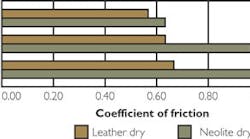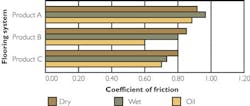Most people don't give floor surfaces much thought until a problem appears. For instance, personnel safety and potential liability may become issues only when floors become slippery under normal operating conditions. Often, a "wet" environment is considered wet only because it requires frequent cleaning to maintain a hygienic environment. Maintaining floors properly to prevent hazardous conditions in kitchens, restrooms, production environments and public lobbies depends on the type of flooring system and the conditions of use. Typically, textured seamless floors are specified if exposure to water, oils, greases or other process materials is a common event. Selecting the right flooring is smart, but it's equally important to develop standard operating procedures for cleaning the floor.
Weighing the conditions
Food processing represents an aggressive environment for flooring. So the flooring systems must withstand chemical attack and abrasion, as well as provide a safe, slip-resistant surface. Bare concrete won't stand up to acid and becomes slippery when fats, oils and water spill on it, so textured flooring is common in these areas.
Resurfacing systems that use 1/4 inch of urethane can withstand the physical and chemical exposures and the thermal shock from steam cleaning. These systems can be finished with a non-slip surface to provide safe walking under almost any condition.
Heavy manufacturing and assembly plants must also address the issue of slip resistance because their floors are exposed to oils and particulate matter. The flooring also must withstand traffic and abrasion. Combining proper floor texture and maintenance procedures minimizes slip hazards in these facilities.
Wet and soiled conditions with low foot traffic are characteristic of commercial kitchens and plant cafeterias. These areas don't undergo the same degree of abuse and steam cleaning as food processing facilities, but slip resistance and a clean environment are equally important. In these situations, a decorative seamless floor, such as a quartz broadcast or a decorative troweled system, is most frequently selected. These systems also typically receive a textured finish to ensure safety.
Lobbies and restrooms are mostly dry with light traffic, although seasonal wet conditions occur, so flooring for these areas is generally selected on the basis of aesthetics. Since light foot traffic and routine cleaning in these areas don't dictate a need for textured floors, terrazzo, marble and tile using an ADA-compliant sealer maintain the desired non-slip surface. Table 1 summarizes exposures, cleaning requirements and texture considerations for these various plant areas.
|
View more flooring content on PlantServices.com |
Marrying texture with safety
A seamless floor can be textured in several ways. The topcoat applied to a flooring system may contribute to the slip resistance, especially if the coating provides a stipple finish. A satin finish features microscopic surface irregularities that can provide slip resistance. Smooth flooring finishes, especially epoxy coatings, tend to abrade over time, which increases slip resistance characteristics.
For more aggressive environments, texture is built into the floor using aggregates. Light service areas can use polypropylene beads to yield a slight texture. Kitchens and shower rooms frequently have colored quartz, broadcast floors, which contain a natural texture based upon the installation procedure. The texture on an aggressive quartz broadcast floor uses a single, thin coat of polyurethane that "follows" the profile. Application of grout coats and topcoats of clear epoxy or urethane actually diminish floor texture. A 100% solid, zero volatile organic content epoxy topcoat "fills" the profile and can reduce the texture.
Heavy manufacturing conditions require a more durable texture that will not be crushed due to the traffic of forklifts and other vehicles. Silica sand is incorporated into the finish surface of slurry/broadcast floors and 1/4 inch trowel applied resurfacing systems for slip resistance. Varying the size of the aggregate also impacts the degree of slip resistance. Larger aggregates, such as a 30-mesh silica sand, provide more slip resistance on a dry surface than the smaller size 40-60 mesh silica.
Wen-Ruey Chang and Associates at the Liberty Mutual Research Center for Safety and Health have studied the role of surface roughness in floors and footwear. They concluded that the combination of the microscopic roughness of the sole and the floor surface affect the coefficient of friction significantly. This principle helps to explain the extreme variances obtained when various waxes and sealers are used on textured floors. It's important to ensure that ADA-compliant sealers and maintenance materials are used in lobbies and restrooms, where a noticeable, macroscopic surface texture is absent.
In our research, the ASM 725 Slip Meter (American Slip Meter, Inc.) was used to measure the static COF of various dry industrial flooring systems with smooth and textured surfaces. The meter determines the force necessary to initiate movement of a weight. Two different grades of aggregate were used, a 40/60 mesh silica sand and a more aggressive 30 mesh silica sand. Results indicated that a smooth surface complies with ADA 0.5 COF recommendations in dry conditions, but the addition of texture to the flooring system dramatically increased the COF for both leather and Neolite (rubber) soles. The 30-mesh aggregate improved slip resistance as represented by an increased COF (see Figure 1).
Figure 1. Effect of texture and footwear on coefficient of friction in dry conditions.
When these tests were duplicated under oily conditions, the smooth surface's performance was below the "safe" recommendations while both textured surfaces exhibited an increase in coefficient of friction. It must be noted that, although these tests provide relative performance for a valid comparison, the static measurement of slip resistance may not fully reflect the degree of "slipperiness" of an individual's walking dynamics. While water and oil exhibit a cohesive force with stationary objects, once moving, the force required to maintain movement is significantly less (see Figure 2).
Figure 2. Effect of texture and footwear on coefficient of friction in oily conditions.
Aluminum oxide provides a non-slip surface in areas subject to the most extreme conditions. Its angular shape yields a high coefficient of friction. Figure 3 illustrates that Neolite (rubber) footwear tends to provide a higher coefficient of friction than leather at every level of flooring system texture. As Figure 4 shows, in dry, wet and oily conditions, the flooring under test maintained a high level of slip resistance. When an epoxy topcoat was applied over the aluminum oxide, the coefficient of friction decreased.
Figure 3. Coefficient of friction of leather and Neolite.
Figure 4. Coefficient of friction with Neolit.
Textured floors are not difficult to clean. Just as their appearances differ from that of a smooth floor, textured floors require a different cleaning process.
Without an effective cleaning procedure, a key benefit of textured flooring — increased coefficient of friction — is quickly lost. The maintenance regimen for such areas is daily or twice daily cleaning plus regular touch-ups for spills. Less frequent cleaning will allow foreign matter to accumulate and reduce the floor's slip resistance.
The first step in cleaning a textured floor is to put away the mops. Mops are not appropriate for cleaning most textured floors, since they tend to shed fibers on abrasive surfaces, and to spread grease and oil films.
The most complex step in cleaning a textured floor is choosing the correct cleaning chemical. Base your choice on the amount and type of foreign matter, the type of flooring surface and the cleaning process. Follow the floor manufacturer's recommendations regarding the type of cleaner to use. If no recommendations are given, then determine the best cleaner based on:
- Type of dirt or foreign matter to be removed. Most cleaners are formulated to remove particular types of dirt.
- The amount of foreign matter accumulation.
- Special problems, such as removing marks from rubber tires.
- Compatibility of the chemicals in the cleaner with the floor's finish.
Addressing these issues narrows the range of cleaner options to a few for trial and evaluation. In controlled laboratory tests, we've confirmed that two cleaners work especially well: fortified alkaline cleaner for light-to-moderate soils and high alkaline cleaner for moderate-to-heavy soils. These products remove contaminants, including food, blood, fats, petroleum oils, dirt, mud and rubber tire marks, from a variety of textured flooring surfaces.
After choosing the proper cleaner, consider four additional issues and guidelines:
- Application. For larger areas, use of an automatic scrubbing machine. Scrubbers dispense the cleaning solution evenly over the floor and also accomplish the second step, agitation, during application. For smaller areas, use a low-pressure sprayer, foamer or deck brush.
- Agitation. This drives the cleaner into the foreign matter, where it dissolves the material from top down. If an automatic scrubber wasn't used, agitate the solution with a deck brush, a rotary machine with a brush head or some similar tool.
- Dwell. Let the chemical do its work. When cleaning a dirty floor, especially one with an accumulation of protein or crude-based soils, the cleaner needs time to dissolve the soil. In most cases, five to ten minutes is enough.
- Removal. Complete or near-complete cleaner removal is key. Leaving a cleaning solution on the floor results in a dirty floor. As the solution evaporates, the dirt has nowhere to go, except back to the floor surface. Remove cleaning solutions using a vacuum process, such as an automatic scrubber or a wet vacuum. For smaller areas, a soft rubber squeegee works well. A hard rubber squeegee is not effective, as it bounces along the textured floor and leaves a lot of solution in its wake. Don't use a water spray to rinse the solution off the floor. This over-dilutes the chemical, causing the dissolved soils to migrate back to the floor surface.
More than a floor
Maintaining a slip-resistant surface may mean providing additional friction, but keep in mind that with friction comes wear. Also, surfaces exposed to constant use erode, so textured floor maintenance requires periodic recoating and renewed texture application. For low foot-traffic conditions and light cleaning programs, restoration will be infrequent. Extreme conditions require more maintenance, perhaps at short intervals.
To ensure proper maintenance of any floor, standard maintenance procedures for each environment should delineate the frequency of cleaning, the correct cleaning agents and the appropriate tools. Though cleaning and maintaining a textured floor presents a challenge to the maintenance staff, it's not an undue burden. Safety of personnel is of primary importance, and the energy and cost associated with maintaining a safe environment pales when compared with the cost of low employee morale and potential accident liability.
With the correct type of textured flooring, the correct cleaning chemicals and the right cleaning procedures for the specific environment, a textured floor will provide years of dependable service without ever becoming a major maintenance headache.
Robert Lussmyer is president of Union Brands, LLC. He can be reached at [email protected] and (859) 384-1497. Thomas Murphy is vice president of The Sherwin-Williams Co. He can be reached at [email protected] and (800)543-7694.





